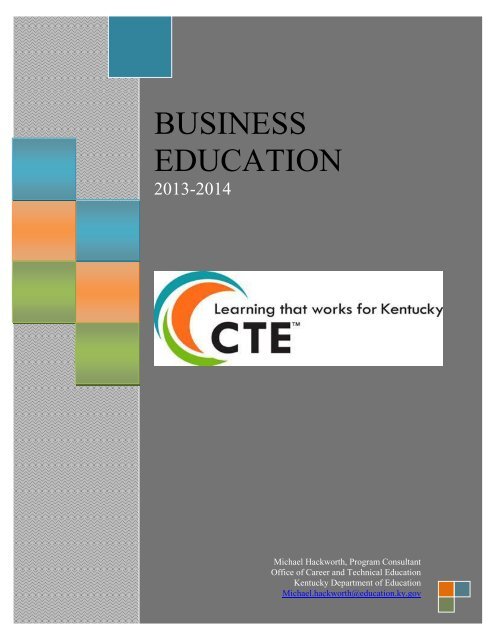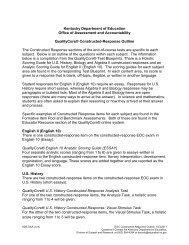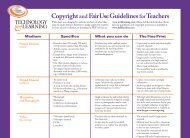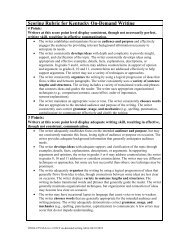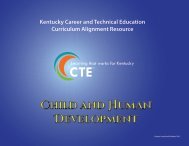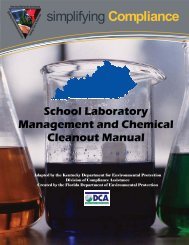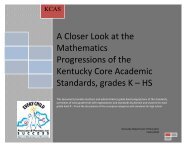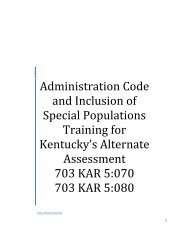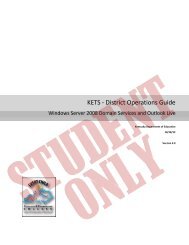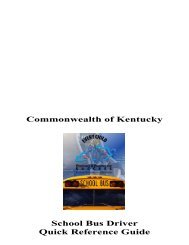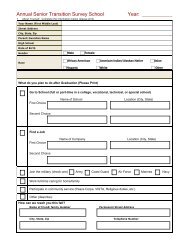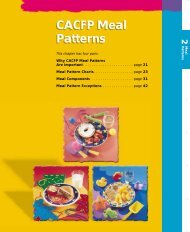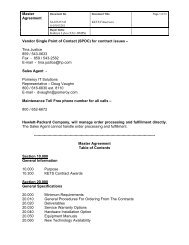Business Education Program of Studies - Kentucky Department of ...
Business Education Program of Studies - Kentucky Department of ...
Business Education Program of Studies - Kentucky Department of ...
You also want an ePaper? Increase the reach of your titles
YUMPU automatically turns print PDFs into web optimized ePapers that Google loves.
BUSINESS EDUCATIONRecommended Grade Level RecommendedCourse TitleLead Code 4 5 6 7 8 9 10 11 12 CreditTouch Keyboarding 4 th -6 th 060114 x x 4 th -6 th gradeComputer and Technologyx6 th gradeConcepts 060160<strong>Business</strong>/Marketing Concepts 060161 x 7 th gradeand ApplicationsKeyboarding Applications 060113 x x 7 th -8 th grade<strong>Business</strong> and Marketing/Career Exploration060195 x x 8 th grade9 th grade 1 creditAccounting and Finance060122 x x x 1FoundationsAdvanced Accounting070125 x x 1(Accounting Bridge Pilot)Advanced Computer and 070743 x x 1Technology Applications*Advanced Finance and060399 x x 1Credit*Advanced Multi-Media* 060761 x x 1<strong>Business</strong> Communication 060155 x x 1<strong>Business</strong> Economics**x x x x 1June 2013060511 (CTE Credit)060596 (EconomicsCredit)<strong>Business</strong> <strong>Education</strong> Co-Op 060107 x 1-3<strong>Business</strong> Law* 060121 x x x 1<strong>Business</strong> Management* 060411 x x 1<strong>Business</strong> Principles and060111 x x 1Applications<strong>Business</strong> Technology 060198 x x x x 1Computer and Technology 060112 x x 1ApplicationsData Modeling/SQL 070331 x x x x 1Entrepreneurship* 060185 x x 1Financial Accounting* 070122 x x 1Financial Literacy060170 (CTE Credit)060171 (MathCredit)x x x x ½ - 1Financial Services I 060311 x x x 1Financial Services II* 060351 x x 1International <strong>Business</strong> 060188 x x 1Leadership Dynamics 060196 x x x x 1Legal Office* 070881 x x 1Mathematics for <strong>Business</strong> andIndustry***060172 (CTE Credit)060190 (MathCredit)x x x x 1Medical Office* 070971 x x 1Micros<strong>of</strong>t Office (MOS)* 070750 x x 1Multi-Media Publishing* 060751 x x x 1Principles <strong>of</strong> Teaching x x x x 1Web Data Management* 073399 x x 1Web Page Design 060199 x x x 1Word Processing 060142 x x x x 1* Effective Fall <strong>of</strong> 2012, students who Co-Op must be enrolled in <strong>Business</strong> <strong>Education</strong> Co-Op along with a capstone course sometime throughout the schoolyear. Capstone courses are marked with *.**<strong>Business</strong> Economics is an interdisciplinary course which meets the graduation requirement for Economics.***Math for <strong>Business</strong> and Industry is an interdisciplinary course which meets the graduation requirement for the fourth math credit.<strong>Business</strong> <strong>Education</strong>
Overview <strong>of</strong> <strong>Business</strong> <strong>Education</strong>BUSINESS EDUCATIONPurpose:The vision <strong>of</strong> <strong>Kentucky</strong> <strong>Business</strong> <strong>Education</strong> is to promote business pr<strong>of</strong>essional development,enhance leadership, provide relevant curriculum, and to be vital to the education <strong>of</strong> all students.<strong>Kentucky</strong> <strong>Business</strong> <strong>Education</strong> will: operate as the center for industry standard desktop and communications technology inschools.provide a critical link in school to employment or postsecondary education.develop stronger relationships with the business community in terms <strong>of</strong> mutualadvocacy, cooperative field experiences, employment placement, and support forFBLA experiences.represent a necessary component in the education <strong>of</strong> all students.require and promote critical thinking and problem solving.<strong>of</strong>fer a flexible curriculum based on standards that adapts to change.integrate academic skills into the business education curriculum in order to insure thatstudents develop excellent written & verbal communications skills, computationalskills, and scientific problem-solving skills.Career Pathways: Accounting Administrative Support <strong>Business</strong> Management <strong>Business</strong> Multimedia <strong>Business</strong> Technology Data Base Management Finance Information Processing Legal Office Medical <strong>Business</strong> Office <strong>Business</strong>/Marketing <strong>Education</strong>Standard Based CurriculumThe curriculum is composed <strong>of</strong> standards based competencies. Therefore, the teaching/learningfocus is on the final results rather than the process. <strong>Business</strong> <strong>Education</strong> Teachers are lecturingless and facilitating more, and as a result, students are taking charge <strong>of</strong> their own learning byusing technology to research topics, collect data and present information orally and in writtenform. More <strong>Business</strong> <strong>Education</strong> <strong>Program</strong>s are incorporating school-based enterprises in order forstudents to apply business and marketing concepts learned in the classroom.June 2013<strong>Business</strong> <strong>Education</strong>
<strong>Kentucky</strong> Occupational Skill StandardsThe <strong>Kentucky</strong> Occupational Skill Standards are the performance specifications that identify theknowledge, skills, and abilities an individual needs to succeed in the workplace. Identifying thenecessary skills is critical to preparing students for entry into employment or postsecondaryeducation. Because <strong>of</strong> the importance <strong>of</strong> skill standards, the Office <strong>of</strong> Career and Technical<strong>Education</strong> in conjunction with employers from the <strong>Kentucky</strong> Bankers Association, InternationalAssociation <strong>of</strong> Administrative Pr<strong>of</strong>essionals, The <strong>Kentucky</strong> Society <strong>of</strong> Certified PublicAccountants, and various business managers (e.g., YUM Brands, United Parcel Service,<strong>Kentucky</strong> Retail Federation, and Kroger) worked to develop a system to certify that students haveattained the necessary skills for employment or postsecondary education. Standards weredeveloped in the areas <strong>of</strong> Financial Services, Administrative Support, Accounting and <strong>Business</strong>Management. These standards described the necessary occupational, academic, andemployability skills needed to enter the workforce or post- secondary education in specificcareer areas. There is an ongoing effort to continue to refine these standards by which exemplary<strong>Business</strong> <strong>Education</strong> <strong>Program</strong>s are evaluated and certified. The strength <strong>of</strong> these businesspartnerships insures that curriculum meets industry specifications.Interdisciplinary CoursesThe <strong>Kentucky</strong> graduation requirements allow for interdisciplinary or applied courses to substitutefor specific academic courses required for graduation. In the business curriculum <strong>Business</strong>Economics meets the graduation requirement for social studies and Mathematics for <strong>Business</strong>and Industry meets the requirement for the 4 th math credit.School Based EnterprisesIn many <strong>Kentucky</strong> high school business programs a school based enterprise is an integral part <strong>of</strong>the curriculum. Running an actual business allows students to learn contextually without leavingschool. Textbook concepts become real as students operate a business.Work Based LearningCooperative experience, internships, shadowing and mentoring opportunities provide depth andbreadth <strong>of</strong> learning in the instructional program and allow students to apply the concepts learnedin the classroom. The Work Based Learning Manual is available on the KDE webpage:www.education.ky.gov.Student OrganizationParticipation in FBLA, Future <strong>Business</strong> Leaders <strong>of</strong> America, provides a vehicle for students toemploy higher order thinking skills, to interact with high-level business people and to furtherenhance their leadership skill through their participation in regional, state and nationalcompetitive events and local activities.June 2013<strong>Business</strong> <strong>Education</strong>
KDE Career Pathways<strong>Business</strong> <strong>Education</strong>2013-2014Career Pathway Sequence <strong>of</strong> Courses Elective CoursesAccountingCIP 52.0301 Computer &Technology Advanced Computer &Technology ApplicationsApplications Advanced AccountingTests for Certification: Accounting & Finance (Accounting Bridge Pilot) KOSSA – AccountingFoundations Advanced Finance & ASK – Concepts <strong>of</strong> Financial Accounting CreditFinance <strong>Business</strong> Economics Quickbooks <strong>Business</strong> Law <strong>Business</strong> Management <strong>Business</strong> Principles &Applications Data Modeling/SQL Other Courses Approvedby <strong>Business</strong> ConsultantRelated to CareerPathwayAdministrative SupportCIP 52.0401Tests for Certification: KOSSA – AdministrativeSupport MOS (3 <strong>of</strong> 4) – Word,Excel, PowerPoint, andAccess IC3 – ComputerFundamentals, KeyApplications, and LivingOnlineComputer &TechnologyApplicationsAccounting andFinance FoundationsAdvanced Computer &TechnologyApplications<strong>Business</strong>Communications<strong>Business</strong> Economics<strong>Business</strong> Management<strong>Business</strong> Principles &ApplicationsData Modeling/SQLLegal OfficeMath for <strong>Business</strong> &IndustryMedical OfficeMicros<strong>of</strong>t OfficeWord ProcessingOther Courses Approvedby <strong>Business</strong> ConsultantRelated to CareerPathwayJune 2013<strong>Business</strong> <strong>Education</strong>
Career Pathway Sequence <strong>of</strong> Courses Elective Courses<strong>Business</strong> Management Computer & <strong>Business</strong> CommunicationCIP 52.0201TechnologyApplications <strong>Business</strong> Principles &ApplicationsTests for Certifications: Accounting & EntrepreneurshipFinance Foundations Financial Accounting KOSSA – <strong>Business</strong> <strong>Business</strong> Law or International <strong>Business</strong>Management<strong>Business</strong> Economics Principles <strong>of</strong> Marketing ASK – Fundamental <strong>Business</strong> Management Web Data Management<strong>Business</strong> Concepts or Other Courses ApprovedConcepts <strong>of</strong>by <strong>Business</strong> ConsultantEntrepreneurship/Related to Career PathwayManagement<strong>Business</strong> MultimediaCIP 52.0501Tests for Certifications: Adobe (1 <strong>of</strong> 3 exams) –Dreamweaver, Flash,and Photoshop MOS (3 <strong>of</strong> 4) – Word,Excel, PowerPoint, andAccess IC3 – ComputerFundamentals, KeyApplications, and LivingOnline CIW Web DesignSpecialist CIW Internet <strong>Business</strong>Associate CIW Site DevelopmentAssociate Apple CertifiedAssociate – iWork LevelOne (9L0-806)Computer &TechnologyApplicationsMultimediaAdvanced MultimediaAdvanced Computer &Technology ApplicationsPromotional Applicationsand MediaWeb Page DesignOther Courses Approvedby <strong>Business</strong> ConsultantRelated to Career PathwayJune 2013<strong>Business</strong> <strong>Education</strong>
Career Pathway Sequence <strong>of</strong> Courses Elective CoursesFinanceCIP 52.0803 Computer &Technology Advanced Accounting(Accounting Bridge Pilot)Applications Advanced Finance & CreditTests for Certifications: Accounting & Finance Financial Services IIFoundations <strong>Business</strong> Communication KOSSA – Financial Financial Services I <strong>Business</strong> EconomicsServices <strong>Business</strong> Law ASK – Concepts <strong>of</strong> Data Modeling/SQLFinance Entrepreneurship Financial Accounting Principles <strong>of</strong> Marketing Other Courses Approved by<strong>Business</strong> Consultant Relatedto Career PathwayInformation ProcessingCIP 52.0407Tests for Certifications: KOSSA –AdministrativeSupport MOS (3 <strong>of</strong> 4) – Word,Excel, PowerPoint, andAccess IC3 – ComputerFundamentals, KeyApplications, andLiving Online Adobe (1 <strong>of</strong> 3 exams)Dreamweaver, Flash,and Photoshop CIW Web DesignSpecialist CIW Internet <strong>Business</strong>Associate CIW Site DevelopmentSpecialistComputer &TechnologyApplicationsAdvanced Computer &TechnologyApplications ORMicros<strong>of</strong>t OfficeMultimedia OR WebDesignAdvanced Multimedia<strong>Business</strong> CommunicationData Modeling/SQLMicros<strong>of</strong>t Office isencouraged.Word ProcessingOther Courses Approved by<strong>Business</strong> Consultant Relatedto Career PathwayJune 2013<strong>Business</strong> <strong>Education</strong>
Legal OfficeCIP 22.0301Tests for Certifications: KOSSA –Career Pathway Sequence <strong>of</strong> Courses Elective Courses Computer & Advanced Computer &TechnologyTechnology ApplicationsApplications <strong>Business</strong> Principles & <strong>Business</strong> LawApplications Legal Office <strong>Business</strong> CommunicationAdministrative Support Data Modeling/SQLMOS (3 <strong>of</strong> 4) – Word, Micros<strong>of</strong>t OfficeExcel, PowerPoint, and Other Courses Approved byAccess<strong>Business</strong> ConsultantIC3 – ComputerRelated to Career PathwayFundamentals, KeyApplications, andLiving OnlineMedical <strong>Business</strong> OfficeCIP 51.0716Tests for Certifications: KOSSA –Administrative Support MOS (3 <strong>of</strong> 4) – Word,Excel, PowerPoint, andAccess IC3 – ComputerFundamentals, KeyApplications, andLiving OnlineComputer &TechnologyApplicationsWord ProcessingMedical OfficeAccounting & FinanceFoundationsAdvanced Computer &Technology Applications<strong>Business</strong> Communication<strong>Business</strong> Principles &ApplicationsData Modeling/SQLMedical TerminologyMicros<strong>of</strong>t OfficeOther Courses Approved by<strong>Business</strong> ConsultantRelated to Career Pathway<strong>Business</strong> & Marketing<strong>Education</strong>CIP 13.1310Tests for Certifications: KOSSA – AdministrativeSupport or Marketing MOS (3 <strong>of</strong> 4) – Word,Excel, PowerPoint, andAccess IC3 – ComputerFundamentals, KeyApplications, and LivingOnline ASK – Fundamental<strong>Business</strong> Concepts orFundamental MarketingConceptsComputer &TechnologyApplicationsPrinciples <strong>of</strong> Teaching<strong>Business</strong> ElectiveMarketing ElectiveOther <strong>Business</strong> &Marketing CoursesJune 2013<strong>Business</strong> <strong>Education</strong>
Touch Keyboarding for 4-6 th GradeCourse Description: This is a six-to-nine week course where students will develop skills inoperating a keyboard by touch with emphasis on entering the alphabet, numbers, and symbolswith proper technique.Content/ProcessStudents will:1. demonstrate proper keyboarding techniques.2. apply formatting to simple documents (letters, reports, and articles).3. apply standard rules <strong>of</strong> spelling, punctuation, grammar, and capitalization.4. organize and maintain workstation.ConnectionsAge-appropriate s<strong>of</strong>tware packagesCommon Core State Standards ELA21 st Century Skills<strong>Kentucky</strong> Cyber Keys: A P-8 Guide to KeyboardingSecretary's Commission on Achieving Necessary Skills (SCANS)June 2013<strong>Business</strong> <strong>Education</strong>
Computer and Technology Concepts – 6 th GradeCourse Description: This course is designed for students who have minimal keyboardingexperience. Computer and Technology Concepts will develop the touch system <strong>of</strong> keying withadded emphasis on the development <strong>of</strong> proper keying techniques, speed and accuracy. The firstsix weeks will focus on proper techniques utilizing the touch system. The final three weeks willallow the students to develop and demonstrate knowledge <strong>of</strong> basic word processing skills such asformatting letters in various letter styles, short reports with and with references, and tables.Additional emphasis will be placed on basic communication skills such as pro<strong>of</strong>reading,grammar, word division and the proper application <strong>of</strong> pro<strong>of</strong>reader’s marks to demonstrate theimportance <strong>of</strong> mail able copy. Different telecommunication concepts may be addressed throughsimulation or application.Students will:Content/Process1. demonstrate keying techniques.2. apply language rules, pro<strong>of</strong>reader’s marks, and reference materials.3. apply basic formatting procedures and manipulate data in letters, reports, simple tables,spreadsheets, graphs and charts, and databases.4. demonstrate electronic communications and telecommunications <strong>of</strong> the following: voice,data, image, text, and video.5. demonstrate how to properly organize and maintain a workstation.6. demonstrate how to transfer documents from a handwritten format into an electronicformat.7. demonstrate correct composition <strong>of</strong> documents.8. demonstrate good work habits and a work ethic that impacts success at school and in theworkplace.9. apply communication skills within the technical content.10. demonstrate employability and social skills relative to the career cluster.11. utilize activities <strong>of</strong> FBLA as an integral component <strong>of</strong> course content and leadershipdevelopment.Connections• Common Core State Standards (ELA)• 21 st Century Skills• <strong>Kentucky</strong> Technology <strong>Program</strong> <strong>of</strong> <strong>Studies</strong>June 2013<strong>Business</strong> <strong>Education</strong>
Keyboarding Applications – 7 th & 8 th GradeCourse Description: This course is designed for students who have little or no keyboardingexperience. Keyboarding Applications will develop the touch system <strong>of</strong> keying with addedemphasis on the development <strong>of</strong> proper keyboarding techniques, speed, and accuracy. Six tonine weeks will be spent developing the touch system. The student will apply techniques forpro<strong>of</strong>reading, editing, word division, capitalization, and punctuation for production <strong>of</strong> mail ablecopies <strong>of</strong> letters, simple business forms, tabulated information, and manuscripts. Aftercompletion <strong>of</strong> Keyboarding Applications, a student may take either Word Processing orComputer and Technology Applications.Content/ProcessStudents will:1. demonstrate keyboard techniques.2. apply language rules, pro<strong>of</strong>reader’s marks, and reference materials.3. apply basic formatting procedures and manipulate data in letters, reports, simple tables,spreadsheets, graphics, graphs and charts, and databases.4. create or simulate electronic communication and telecommunications <strong>of</strong> the following:voice, data, image, text, and video.5. compose documents.6. research and analyze career opportunities in computer-related careers.7. complete a career portfolio which includes letter <strong>of</strong> application, employment application,letter <strong>of</strong> reference, resume, interviewing techniques, follow-up letter, and letter <strong>of</strong>resignation.8. develop good work habits and a work ethic that impacts success at school and in theworkplace.9. utilize activities <strong>of</strong> FBLA as an integral component <strong>of</strong> course content and leadershipdevelopment.10. apply communication skills within the technical content.11. demonstrate employability and social skills relative to the career cluster.Connections Common Core State Standards ELA 21 st Century Skills Technology <strong>Program</strong> <strong>of</strong> <strong>Studies</strong>June 2013<strong>Business</strong> <strong>Education</strong>
<strong>Business</strong> and Marketing Career Exploration - 8 th & 9 th GradeCourse Description: This course provides students with a survey <strong>of</strong> skills needed for school-toworktransition. Opportunities to explore the business and marketing career cluster and careerpaths, to heighten self-awareness, and to develop priorities and career decision-making skills arealso provided. A variety <strong>of</strong> instructional resources, self-assessment instruments, and career interestsurveys are included in the updating <strong>of</strong> the Individual Learning Plan (ILP). Interpersonal skilldevelopment and orientation to word processing, computer spreadsheet, and database are included.Leadership development will be provided through FBLA and/or DECA. (This course is crossreferenced with Marketing <strong>Education</strong>.)Content/ProcessStudents will:1. reinforce basic skills in human relations and in both written and oral communicationincluding customer relations.2. develop a personal portfolio <strong>of</strong> careers to explore; research and prepare reports aboutbusiness and marketing careers.3. complete self-assessment surveys to link interests, hobbies, skills, and school subjects tooccupations.4. complete a career interest survey identifying general likes and dislikes, personal skills, andjob values.5. complete a job application, compose a resume and a letter <strong>of</strong> application, and prepare for aninterview.6. define world <strong>of</strong> work vocabulary; explain concepts relating to the world <strong>of</strong> work; andexplore the importance <strong>of</strong> business ethics.7. develop and/or update Individual Learning Plans.8. develop decision-making, problem-solving, and critical thinking skills to become life-longlearners and self-directed individuals.9. develop and key a budget using spreadsheet and database s<strong>of</strong>tware, based upon a desiredadult lifestyle.10. identify and summarize why people need to work to meet basic needs.11. describe what academic skills are needed for a career in the business and marketing cluster.12. explain & evaluate resources that can be used for researching job and career information.13. describe and explain the importance <strong>of</strong> good work habits/ethics in the workplace.14. explain how jobs/careers have been created as a result <strong>of</strong> scientific and technologicaladvancements.15. identify and explain skills used to seek, obtain, maintain, and change jobs/careers.16. apply communication skills within the technical content.17. demonstrate employability and social skills relative to the career cluster.18. utilize activities <strong>of</strong> FBLA and/or DECA as an integral component <strong>of</strong> course content andleadership development.Connections Secretary's Commission on Achieving Necessary Skills (SCANS) Common Core State Standards ELA 21 st Century Skills Individual Learning Plan – Career CruisingJune 2013<strong>Business</strong> <strong>Education</strong>
Accounting and Finance FoundationsCourse Description: This course will provide an introduction to both areas <strong>of</strong> accounting andfinance. Topics will 8ninclude banking, credit, financial literacy, career exploration, spreadsheetusage, and technical writing. The accounting principles taught in this course are based on a doubleentrysystem and include preparing bank reconciliations, payroll taxes, and financial statements.Detailed career exploration in the various fields <strong>of</strong> accounting will be available. Technical writingwill be provided through IPAC business plan curriculum and exploration <strong>of</strong> case studies.Leadership development will be provided through FBLA.Content/ProcessStudents will:1. demonstrate financial calculations used by the business pr<strong>of</strong>essional.2. research and analyze career opportunities in accounting and develop an employment portfolio(letter <strong>of</strong> application, resume, etc.).3. examine the importance <strong>of</strong> work/business ethics.4. demonstrate employability and social skills relative to the career cluster.5. research Internet safety and e-commerce regulations.6. assess the characteristics <strong>of</strong> money and the government’s role in the economy.7. describe economic institutions such as banks and stock markets.8. identify banking procedures and apply correct accounting methods for all financial records.9. distinguish differences in business structures such as proprietorships, partnerships, andcorporations.10. analyze and justify purpose for double-entry accounting.11. explain accounting terms and concepts: automated accounting, accounting cycle, accountingframework, and account classifications.12. apply math, communication, and accounting skills in preparing and analyzing businesstransactions and financial statements through ratio analysis, break-even, productivity, costbenefitanalysis, and time value <strong>of</strong> money.13. demonstrate the ability to create and analyze spreadsheets (payroll, budgets, etc.) using Excel.14. be able to calculate payroll earnings and payroll taxes including but not limited to FICA,Federal, FUTA, and SUTA.15. determine and complete the tax documents beginning with the W-4 through 1040 EZ.16. develop an understanding <strong>of</strong> credit transactions including the laws that govern these functions.17. analyze business financial conditions through case studies.18. utilize activities <strong>of</strong> FBLA as an integral component <strong>of</strong> course content and leadershipdevelopment.Connections <strong>Kentucky</strong> Occupational Skill Standards Secretary's Commission on Achieving Necessary Skills (SCANS) Common Core State Standards ELA and Math 21 st Century SkillsTo receive copies <strong>of</strong> the curriculum for this course, please contact program consultant.June 2013<strong>Business</strong> <strong>Education</strong>
Advanced Accounting (Accounting Pilot and Bridge Project)Course Description: College Accounting/Advanced Accounting uses an integrated approach to teach accounting. Students firstlearn how businesses plan for and evaluate their operating, financing, and investing decisions and how accounting systems gatherand provide data to internal and external decisions makers. This year-long course covers all the learning objectives <strong>of</strong> atraditional college level financial accounting course, plus those from a managerial accounting course. Topics include anintroduction to accounting, accounting information systems, time value <strong>of</strong> money, and accounting for merchandising firms, salesand receivables, fixed assets, debt and equity. Other topics include statement <strong>of</strong> cash flows, financial ratios, cost-volume pr<strong>of</strong>itanalysis and variance analysis. Leadership development will be provided through FBLA. (Teachers must go through a 3 daytraining to teach this course)Content/ProcessStudents will:1. Explain how and why the conceptual framework <strong>of</strong> accounting and generally accepted accounting principles provide guidance andstructure for preparing financial statements.2. Describe the information provided in each financial statement and how the statements articulate with each other.3. Identify business ownership structures.4. Explain the role <strong>of</strong> management and the auditor in preparing and issuing an annual report.5. Identify and explain the classifications within assets, liabilities, and equity.6. Define and calculate the current ratio, debt-equity ratio, return on sales, and return on equity.7. Identify and explain the three phases <strong>of</strong> the management cycle and the four business processes.8. Explain and calculate the operating cycle ( accounts receivable turnover and inventory turnover)9. Explain how internal control procedures are used to safeguard assets.10. Prepare bank reconciliation.11. Describe the purpose <strong>of</strong> journals and ledgers and their relationship.12. Analyze and describe how business transactions impact the accounting equation.13. Apply the double-entry system <strong>of</strong> accounting to record business transactions and prepare a trial balance.14. Explain the need for adjusting entries and record adjusting entries.15. Prepare the financial statements for the different types <strong>of</strong> business operations and ownership structures.16. Explain the purposes <strong>of</strong> the closing process and record closing entries.17. Describe the differences between the periodic and perpetual inventory systems and record transactions.18. Describe the difference between the gross price method and the net price method and record transactions.19. Determine cash paid for inventory and operating expenses.20. Identify and describe the cost flow assumptions for inventory and explain the impact on the balance sheet and income statement.21. Calculate cost <strong>of</strong> goods sold and ending inventory using LIFO and FIFO inventory costing methods.22. Explain how inventory for a manufacturing business differs from inventory for a merchandising business.23. Explain how an activity-based costing system operates, including the identification <strong>of</strong> activity cost pools, and the selection <strong>of</strong> cost driversand explain the flow <strong>of</strong> costs through the manufacturing accounts used in product costing.24. Compute a predetermined overhead rate, and explain its use in job-order costing.25. Determine whether manufacturing overhead is over/under-applied.26. Prepare journal entries to record the costs <strong>of</strong> direct material, direct labor, and manufacturing overhead in a job-order costing system.27. Prepare a schedule <strong>of</strong> cost <strong>of</strong> goods manufactured, a schedule <strong>of</strong> cost <strong>of</strong> goods sold, and an income statement for a manufacturer.28. Complete the steps in the accounting cycle and prepare financial statements.29. Calculate payroll taxes.30. Determine the present value and future value cash flows31. Use net present value concepts to make investment decisions.32. Explain the purpose and methods <strong>of</strong> cost allocation.33. Calculate and record depreciation, depletion and amortization and explain the impact on the financial statements.34. Record the sale and disposal <strong>of</strong> fixed assets and the impact on the financial statements.35. Compare and contrast debt and equity financing.36. Define and calculate TIE (Times-interest-earned ratio)37. Compare and contrast a periodic payment note payable, a lump-sum note payable, and a periodic and lump-sum note payable.38. Calculate the carrying value, interest expense and cash payment for note.39. Record transactions for notes payable: issuance and interest expense.40. Record transactions for bonds issued at face value, a premium and a discount.41. Record interest expense for bonds issued at face value, a premium and a discount using the straight-line method and effective-interestmethod.42. Identify and describe the different classes <strong>of</strong> stock and explain the rights afforded each class <strong>of</strong> stock and record transactions.43. Describe the difference between cash dividends, stock dividends and stock splits, and the impact on the financial statements.44. Utilize activities <strong>of</strong> FBLA as an integral component <strong>of</strong> course content and leadership development.45. Demonstrate employability and social skills relative to the career cluster.46. Apply math and communication skills within the technical content.June 2013<strong>Business</strong> <strong>Education</strong>
June 2013Advanced Computer and Technology ApplicationsCourse Description: This course is designed to provide students an advanced-level experience withpractical applications through hands-on instruction. Course content will include understanding <strong>of</strong> carioushardware, s<strong>of</strong>tware, operating systems, care/operations, administrative applications, and employabilityskills. The s<strong>of</strong>tware includes advanced business applications using word processing, presentation,spreadsheets, database management, desktop publishing, and electronic communication. Leadershipdevelopment will be provided through FBLA. Upon completion <strong>of</strong> this course, a student will be ready totake the core level tests for MOS Certification and/or the Administrative Support Skill StandardAssessment. Suggested Prerequisite: Computer and Technology ApplicationsContent / ProcessStudents will:1. identify, describe, and use different types <strong>of</strong> electronic communications and apply businesscommunication and netiquette skills to create, send, receive, and reply to electronic communication,including e-mail and telephone.2. demonstrate employability and social skills relative to the career cluster (includes cell phone,Internet netiquette, introductions, and grammar).3. compose and illustrate an oral report using appropriate visual aids (presentation s<strong>of</strong>tware, etc).4. demonstrate advance computer applications to create, edit, save, revise, and print word processingdocuments, spreadsheets and related charts, database files, reports, and presentations.5. show advanced s<strong>of</strong>tware integration skills to create new documents through the use <strong>of</strong> wordprocessing, spreadsheets and related charts, database files, reports, and presentations.6. demonstrate advanced skills to design, create, edit, save, and print desktop publishing documentswhich include text, graphics, borders, shadings, watermarks, columns, and nameplates usingprinciples <strong>of</strong> layout and design.7. demonstrate advanced skills to utilize the mail merge feature <strong>of</strong> a s<strong>of</strong>tware program.8. demonstrate advanced skills to apply financial and database functions to spreadsheets includingformulas, data tables, sorting, and queries.9. demonstrate advanced skills using a spreadsheet program to create and work with templates,wizards, and multiple spreadsheets and workbooks.10. demonstrate advanced skills using a database program to create enhanced reports.11. demonstrate advanced skills using presentation s<strong>of</strong>tware to include diagrams, color and graphicmodifications, animation schemes, custom backgrounds, action buttons, hyperlinks, sound, video,and speaker notes.12. demonstrate advanced skills using word processing, spreadsheet, database, and presentations<strong>of</strong>tware to complete workgroup collaboration to include inserting and reviewing comments.13. research and analyze career opportunities, participate in a job interview, and develop anemployment portfolio (letter <strong>of</strong> application, resume, and follow-up letter).14. develop FBLA projects using a variety <strong>of</strong> s<strong>of</strong>tware applications.15. utilize activities <strong>of</strong> FBLA as an integral component <strong>of</strong> course content, leadership development, andservice learning.16. analyze various hardware, s<strong>of</strong>tware, operating systems, and emerging technologies used by businessand industry, such as speech recognition and personal digital assistants.17. integrate math, science, reading and business communication skills within the technical content.18. demonstrate work-based learning (shadowing, mentoring, and co-op, etc.).19. review pro<strong>of</strong>readers’ marks, spell check and thesaurus, reference materials, and grammar check.Connections National Standards for <strong>Business</strong> <strong>Education</strong> Secretary’s Commission on Achieving Necessary Skills (SCANS) Micros<strong>of</strong>t Office Specialists (MOS) <strong>Kentucky</strong> Core Academic Standards – Big Ideas Common Core Standards for Mathematics and English/Language Arts <strong>Kentucky</strong> Occupational Skills Standards Assessment (KOSSA) Standards<strong>Business</strong> <strong>Education</strong>
Advanced Finance and CreditCourse Description: This course is designed to develop an understanding <strong>of</strong> financial markets,investing institutions, and the finance and credit industry in our economic system. It includes anintroduction to the allocation <strong>of</strong> financial resources, the effects <strong>of</strong> the finance and credit institutions onthe business community, and the impact that financial decisions have on the consumer market. Areas <strong>of</strong>study include stock markets, bonds, futures, commodities, interest rates and the economy, interpretation<strong>of</strong> financial information, insurance and risk management, and job opportunities in the finance and creditarea. This course should include real and/or simulated occupational experiences and projects.Leadership development will be provided through FBLA and/or DECA. (This course is cross referencedwith Marketing <strong>Education</strong>.)SUGGESTED PREREQUISITE: <strong>Business</strong> Principles and Applications OR <strong>Business</strong> Economics ORFinancial Services I.Content/ProcessStudents will:1. recognize characteristics <strong>of</strong> good customer service.2. develop an understanding <strong>of</strong> credit transactions including the laws that govern these functions.3. apply math and communication skills within the technical content.4. explain buying and selling stock, identify the various stock exchanges and indices, anddiscuss/interpret the conditions that affect stock market fluctuations.5. develop an understanding <strong>of</strong> the pr<strong>of</strong>it objective <strong>of</strong> a financial institution.6. investigate and discuss the federal and state deposit insurance guidelines and practices.7. distinguish among various types <strong>of</strong> risk (economic, natural, human, pure, speculative, etc.) andevaluate the handling <strong>of</strong> business risk.8. develop appropriate advertising campaign for financial institution; prepare marketing proceduresfor paper products and services.9. differentiate between terminology for credit and savings transactions.10. apply math, communication, and accounting skills in preparing and analyzing financialstatements.11. research career opportunities in the finance and credit industry.12. demonstrate employability and social skills relative to the career cluster.13. explain and analyze the sources <strong>of</strong> revenue for federal, state, and local governments.14. identify sources and functions <strong>of</strong> consumer credit and explain the relationship <strong>of</strong> consumers withthe economy.15. analyze various aspects <strong>of</strong> foreign trade and finance, including foreign exchange and balance <strong>of</strong>trade.16. differentiate between recession and depression.17. examine financial management as it relates to government and business.18. utilize activities <strong>of</strong> FBLA and/or DECA as an integral component <strong>of</strong> course content andleadership development.Connections Secretary's Commission on Achieving Necessary Skills (SCANS) National <strong>Business</strong> <strong>Education</strong> Standards 21 st Century Skills MBA Research Standards <strong>Kentucky</strong> Occupational Skill Standards Common Core State Standards ELA and MathJune 2013<strong>Business</strong> <strong>Education</strong>
Advanced Multimedia PublishingCourse Description: This hands-on course applies advanced web design, publishing, andpresentation concepts through the development <strong>of</strong> sophisticated documents and projects whichincludes, but is not limited to: web sites, web databases, web movies, video editing andproduction, television productions. The course is designed around the learning goals <strong>of</strong> thestudents and is project-based. Students will complete advanced projects agreed upon with theinstructor utilizing hardware and s<strong>of</strong>tware available. Formatting, editing, layout, and designconcepts are reviewed and reinforced. Distribution ready publication standards are applied to allprojects. Students will develop communication skills, problem-solving techniques, cooperativelearning, and interpersonal skills. Leadership development will be provided through FBLA.SUGGESTED PREREQUISITE: Multimedia PublishingContent/ProcessStudents will:1. use industry-standard hardware and s<strong>of</strong>tware components to create advanced multimediaprojects (scanners, digital and video cameras, production equipment, etc)2. demonstrate an awareness <strong>of</strong> copyright, licensing, and downloading and safety issues3. design and publish a web site with dynamic content using HTML and/or advancedfeatures <strong>of</strong> a s<strong>of</strong>tware package including: tables, forms, edited images, animated gifs,.sound, web movies (Flash), databases, forums, etc.4. incorporate features into web pages for different audiences and cultures and handicapaccessibility5. observe and practice safety precautions applicable to both classroom and home use <strong>of</strong> theInternet.6. create movies incorporating advanced features <strong>of</strong> video editing s<strong>of</strong>tware,7. broadcast news programs, feature programs, etc. school-wide8. demonstrate employability and social skills relative to the career cluster.9. utilize activities <strong>of</strong> FBLA as an integral component <strong>of</strong> course content and leadershipdevelopment.10. apply math, science, and communication skills relative to the career major.11. research and analyze career opportunities in multimedia publishing and graphic arts, videoproduction, broadcast, web design, etc.12. identify browser restrictions and variations13. analyze, create, and organize navigational links.14. implement CGI and JavaScript programming where appropriate.15. develop an awareness <strong>of</strong> page load time with various connections <strong>of</strong> users16. recognize appropriate backgrounds, fonts, etc. for business web sites.17. demonstrate Internet etiquette.18. publish web pages to a web server.19. formulate a user-friendly file structure for web publishing.ConnectionsSecretary's Commission on Achieving Necessary Skills (SCANS)<strong>Kentucky</strong> Technology <strong>Program</strong> <strong>of</strong> <strong>Studies</strong>21 st Century SkillsCommon Core State Standards ELAJune 2013<strong>Business</strong> <strong>Education</strong>
<strong>Business</strong> CommunicationCourse Description: <strong>Business</strong> Communication is the study <strong>of</strong> written, oral, and electroniccommunication in a business environment. Emphasis is on writing letters, preparing and orallypresenting business reports, using the telephone in business, electronic transfer <strong>of</strong> information, usingbusiness information resources, listening and interpreting, and developing business messages.Leadership development will be provided through FBLA.SUGGESTED PREREQUISITE: Computer and Technology ApplicationsContent/ProcessStudents will:1. identify the parts <strong>of</strong> speech, apply language arts rules, and use reference materials.2. utilize grammar check, spell check, thesaurus, and pro<strong>of</strong>reader’s marks.3. compose various types <strong>of</strong> business documents electronically, including those associated withemployment.4. identify, describe, and use different types <strong>of</strong> electronic communications.5. demonstrate proper telephone etiquette.6. demonstrate job interviewing techniques and develop a career portfolio (resume, letter <strong>of</strong>application, etc.).7. research career opportunities in business communication-related careers.8. compose and illustrate an oral report using appropriate visual aids (presentation s<strong>of</strong>tware, etc.).9. utilize activities <strong>of</strong> FBLA as an integral component <strong>of</strong> course content and leadershipdevelopment.10. demonstrate employability and social skills relative to the career cluster.11. apply math and communication skills within the technical content.Connections Secretary's Commission on Achieving Necessary Skills (SCANS) National <strong>Business</strong> <strong>Education</strong> Standards 21 st Century Skills Common Core State Standards ELAJune 2013<strong>Business</strong> <strong>Education</strong>
June 2013<strong>Business</strong> EconomicsCourse Description: This course is designed to be a comprehensive study <strong>of</strong> economics which meets theeconomics requirement for graduation. It provides an in-depth study <strong>of</strong> how people produce, distribute, andconsume goods and services. Economic terminology, theory, and a comparison <strong>of</strong> economic systems andpolicies are integral to the course. Simulations and/or actual work situations may be used to providepractical experience with various economic conditions. Leadership development will be provided throughFBLA/DECA.Content/ProcessStudents will:1. explain how laws & government mandates have been adopted to maintain competition in the US & inthe global marketplace.2. demonstrate an understanding <strong>of</strong> the cause/effect <strong>of</strong> business cycles and how monetary and fiscalpolicy can be used to regulate these problems.3. compare & contrast a market economy, command economy, mixed economy and traditional economybased on their abilities to achieve social goals such as freedom, equity, & growth in the modernworld.4. analyze the changing relationships among business, labor, and govt. and how each has affectedproduction, distribution, and consumption .5. utilize decision-making models to make economic choices and determine the opportunity cost <strong>of</strong>those choices.6. utilize activities <strong>of</strong> FBLA and/or DECA as an integral component <strong>of</strong> course content and leadershipdevelopment.7. explain how, in a free enterprise system, individuals attempt to maximize their pr<strong>of</strong>its based on theirrole in the economy.8. understand why people from other nations have come to the United States because <strong>of</strong> economicopportunities.9. demonstrate employability and social skills relative to the career cluster.10. analyze economic concepts and understand their relevance to different economic situations.11. analyze the impact <strong>of</strong> international issues and concerns on personal, national, and internationaleconomics.12. analyze the role culture plays in economic issues <strong>of</strong> production, distribution, and consumption <strong>of</strong>goods and services.13. create graphs that illustrate shortages and surplus and describe how the market works to eliminatethese conditions; identify the effects each change has on equilibrium, price and quantity.14. explain & give examples <strong>of</strong> how numerous factors influence the supply & demand <strong>of</strong> products.15. understand that scarcity is the basic economic problem facing individuals, societies, and nations.16. analyze how a nation’s wealth and trade potential are tied to its’ resources.17. explore how international trade and multinational companies have led to a global economy.18. understand how the United States’ economy has changed from a rural to an industrial economy to aleader in the global economy.19. appraise the effects <strong>of</strong> technological changes, changes in consumer preferences, price inputs,environment, and legislation on supply and demand and price <strong>of</strong> goods/services.20. create demand curve graph for two firms (one monopoly and one oligopoly) and explain the levels <strong>of</strong>output for a firm in perfect conditions21. apply math and communication skills within the technical content.Connections Secretary’s Commission on Achieving Necessary Skills (SCANS) National <strong>Business</strong> <strong>Education</strong> Standards 21 st Century Skills Common Core State Standards ELA and Math Interdisciplinary Course<strong>Business</strong> <strong>Education</strong>
<strong>Business</strong> LawCourse Description: This course develops an understanding <strong>of</strong> legal rights and responsibilities in personallaw and business law with applications applied to everyday roles as consumers, citizens, and workers. Thestudent will have an understanding <strong>of</strong> the American legal system, courts/court procedures, criminal justicesystem, torts, the civil justice system, oral and written contracts, sales contracts and warranties, andconsumer protection. Legal terminology is emphasized. Leadership development will be provided throughFBLA.Content/ProcessStudents will:1. identify ways laws affect individuals, sources <strong>of</strong> law, constitutional rights and responsibilities <strong>of</strong> U.S.citizens, and the responsibilities <strong>of</strong> government.2. describe and analyze the American Legal System3. compare and contrast elements <strong>of</strong> civil (torts) and criminal law4. identify the essentials <strong>of</strong> a contract and examine the characteristics <strong>of</strong> contracts.5. explain various aspects <strong>of</strong> consumer protection including deceptive advertising, agencies which aid theconsumer, and federal legislation.6. Explain commercial contracts and warranties.7. explain about real and personal property and wills8. examine and evaluate leasing <strong>of</strong> real property9. examine and evaluate property and casualty insurance10. describe rights and duties <strong>of</strong> employee, employer, and independent contractor and other importantaspects <strong>of</strong> employment.11. identify legislation (e.g., civil rights, right to privacy, and ADA) affecting personnel practices (e.g.,compensation, promotion, recruitment, selection, termination, and training and development).12. describe legal reasons for terminating employees (e.g., employment at will, embezzlement, violation <strong>of</strong>company policy).13. examine ways businesses can be created including their rights, limitations, and liabilities.14. examine and evaluate a code <strong>of</strong> ethics (i.e., business & personal).15. develop an understanding <strong>of</strong> a business’s responsibility to know, abide by, and enforce laws andregulations that affect business operations and transactions (anti-trust laws, organized labor, andregulatory agencies).16. apply ethical considerations resulting from various situation (e.g., technological advances, internationalcompetition, employer-employee relationship, and consumer relations).17. research career opportunities in the legal pr<strong>of</strong>ession.18. utilize activities <strong>of</strong> FBLA as an integral component <strong>of</strong> course content and leadership development.19. demonstrate employability and social skills relative to the career cluster.20. apply communication skills within the technical content.21. differentiate between different types <strong>of</strong> bankruptcy filings.Connections<strong>Kentucky</strong> Occupational Skill StandardsNational <strong>Business</strong> <strong>Education</strong> StandardsCommon Core State Standards – ELA21 st Century SkillsJune 2013<strong>Business</strong> <strong>Education</strong>
<strong>Business</strong> ManagementCourse Description: This course emphasizes the skills needed for managing a business that involves the selection andsupervision <strong>of</strong> employees including efficient use <strong>of</strong> time, personnel, facilities, and financial resources. Students willexplore forms <strong>of</strong> business ownership; typical business organizational structure; product or service promotion in business;effective communications; human relations skills required in dealing with employees; and effective managementstrategies used in personnel, finance, production, marketing, and information processing. Leadership development willbe provided through FBLA/DECA..Content/ProcessStudents will:1. research the structure <strong>of</strong> business ownership and explain considerations in business planning.2. identify and explain basic functions <strong>of</strong> management, management styles, criteria used in setting and achieving goals,leadership characteristics, and procedures for monitoring and evaluating employee performance.3. discuss how global issues and international trade has and will affect management types, styles, and trends.4. explain the importance <strong>of</strong> various business mgt skills (e.g., time management, handling positive & negativestressors in the business environment, and opportunities for employee’s pr<strong>of</strong>essional growth).5. describe the importance <strong>of</strong> a business and a personal code <strong>of</strong> ethics.6. analyze how the impact <strong>of</strong> human resource management activities help organizations achieve goals.7. compare and contrast various forms <strong>of</strong> competition (i.e., pure competition, monopolistic competition, oligopoly, andmonopoly).8. utilize SWOT (Strengths, Weaknesses, Opportunities, and Threats) analysis when analyzing case studies andbusiness plans.9. understand the economic principles and concepts fundamental to business operations (e.g., entrepreneurship,scarcity, cost <strong>of</strong> inputs, and opportunity cost).10. compare and contrast various types <strong>of</strong> economic systems (i.e., traditional, command, market, and mixed).11. explain & give examples <strong>of</strong> how numerous factors influence the supply & demand <strong>of</strong> products.12. analyze financial data influenced by internal and external factors in order to make short-term and long-termdecisions.13. identify and explain the impact <strong>of</strong> financial risk to the success <strong>of</strong> a business.14. prepare and analyze a business budget as it is used for a decision-making tool.15. identify and explain the importance <strong>of</strong> operations management to a business (e.g., coordination <strong>of</strong> production,quality management, product development, production scheduling, and inventory control).16. describe the nine functions <strong>of</strong> marketing (i.e., purchasing, selling, pricing, product planning, marketing informationmgt., promotion, financing, distribution, risk management).17. evaluate and create a business plan.18. research and analyze career opportunities in management and demonstrate leadership characteristics.19. develop an employment portfolio (resume, letters <strong>of</strong> reference, etc.) and demonstrate job interview techniques.20. research and cite major laws/regulations that affect management and examine the importance <strong>of</strong> work ethic.21. utilize activities <strong>of</strong> FBLA/DECA as an integral component <strong>of</strong> course content and leadership development.22. participate in work-based learning (mentoring, shadowing, co-op, etc.) and service learning.23. demonstrate employability and social skills relative to the career cluster.24. apply math and communication skills within the technical content.Connections Secretary's Commission on Achieving Necessary Skills (SCANS) <strong>Business</strong> Management <strong>Kentucky</strong> Occupational Skill Standard National <strong>Business</strong> <strong>Education</strong> Standards Common Core State Standards ELA and Math 21 st Century Skills Assessment <strong>of</strong> Skills and Knowledge for <strong>Business</strong> (ASK) <strong>Business</strong> Principles or ManagementJune 2013<strong>Business</strong> <strong>Education</strong>
<strong>Business</strong> and Marketing Career Exploration - 8 th & 9 th GradeCourse Description: This course provides students with a survey <strong>of</strong> skills needed for school-to-worktransition. Opportunities to explore the business and marketing career cluster and career paths, to heightenself-awareness, and to develop priorities and career decision-making skills are also provided. A variety <strong>of</strong>instructional resources, self-assessment instruments, and career interest surveys are included. Interpersonalskill development and orientation to word processing, computer spreadsheet, and database are included.Leadership development will be provided through FBLA and/or DECA. (This course is cross referencedwith Marketing <strong>Education</strong>.)Content/ProcessStudents will:1. reinforce basic skills in human relations and in both written and oral communication includingcustomer relations.2. develop a personal portfolio <strong>of</strong> careers to explore; research and prepare reports about businessand marketing careers.3. complete self-assessment surveys to link interests, hobbies, skills, and school subjects tooccupations.4. complete a career interest survey identifying general likes and dislikes, personal skills, and jobvalues.5. complete a job application, compose a resume and a letter <strong>of</strong> application, and prepare for aninterview.6. define world <strong>of</strong> work vocabulary; explain concepts relating to the world <strong>of</strong> work; and explore theimportance <strong>of</strong> business ethics.7. develop and/or update Individual Graduation/Career Plans.8. develop decision-making, problem-solving, and critical thinking skills to become life-longlearners and self-directed individuals.9. develop and key a budget using spreadsheet and database s<strong>of</strong>tware, based upon a desired adultlifestyle.10. identify and summarize why people need to work to meet basic needs.11. describe what academic skills are needed for a career in the business and marketing cluster.12. explain & evaluate resources that can be used for researching job and career information.13. describe and explain the importance <strong>of</strong> good work habits/ethics in the workplace.14. explain how jobs/careers have been created as a result <strong>of</strong> scientific and technologicaladvancements.15. identify and explain skills used to seek, obtain, maintain, and change jobs/careers.16. apply communication skills within the technical content.17. demonstrate employability and social skills relative to the career cluster.18. utilize activities <strong>of</strong> FBLA and/or DECA as an integral component <strong>of</strong> course content andleadership development.Connections Secretary's Commission on Achieving Necessary Skills (SCANS) Common Core State Standards ELA 21 st Century Skills ILP – Individual Learning PlanJune 2013<strong>Business</strong> <strong>Education</strong>
<strong>Business</strong> Principles and ApplicationsCourse Description: This course establishes basic foundations for further study in business andmarketing courses and provides essential information for making financial and economicdecisions. Students learn about the fundamentals <strong>of</strong> the American free enterprise system andworld economies; application <strong>of</strong> sound money management for personal and family finances;credit management; consumer rights and responsibilities; forms <strong>of</strong> business ownership; risk andinsurance; and the importance <strong>of</strong> international trade. Leadership development will be providedthrough FBLA and/or DECA. (This course is cross referenced with Marketing <strong>Education</strong>.)Content/ProcessStudents will:1. explain characteristics <strong>of</strong> the free enterprise system and economic growth, the law<strong>of</strong> supply and demand, role <strong>of</strong> automation and computers, the interdependency <strong>of</strong>people, and the importance <strong>of</strong> world trade.2. identify and analyze constitutional freedom, responsibilities, and rights <strong>of</strong> U.S.citizens, and discuss business ethics and areas in which businesses are thought tohave social responsibility.3. differentiate capitalism, socialism, and communism; and identify demographic,geographic, and psychographic trends in consumer market.4. compare sole proprietorship, partnership, corporation, and cooperative; compareconsumers’ cooperative to a producers’ cooperative.5. identify major types <strong>of</strong> financial institutions and define and explain terms relatingto credit; explain what is involved in financial security, insurance and retirementplanning, and saving and investing.6. research and analyze career opportunities in business and marketing and therelationship <strong>of</strong> education, employment, and wages; identify and describe good jobsearch techniques; and prepare the necessary job application tools.7. analyze and discuss the role <strong>of</strong> the consumer; and recognize consumer rights andresponsibilities; distinguish consumer and industrial markets.8. identify and explain what is involved in budgeting and demonstrate budgeting andrecordkeeping; and examine aspects <strong>of</strong> resource management such as personaldecision making and housing and automobile decisions (including insurance).9. identify and explain government and labor’s role in business including the role <strong>of</strong>labor unions and taxation.10. identify the nine functions <strong>of</strong> marketing and explain the economic value <strong>of</strong>marketing.11. utilize activities <strong>of</strong> FBLA and/or DECA student organizations as an integralcomponent <strong>of</strong> course content and leadership development.12. demonstrate employability and social skills relative to the career cluster.13. apply math and communication skills within the technical content.Connections Secretary's Commission on Achieving Necessary Skills (SCANS) National <strong>Business</strong> <strong>Education</strong> Standards 21 st Century Skills Common Core State Standards ELA and MathJune 2013<strong>Business</strong> <strong>Education</strong>
<strong>Business</strong> TechnologyCourse Description: This course is designed to be a hands-on exploration <strong>of</strong> business technologiesin the following areas: accounting, finance and credit, business management, marketing, economics,and computer applications. Leadership development will be provided through FBLA.Content/ProcessStudents will:1. identify basic accounting terminology and concepts.2. identify major types <strong>of</strong> financial institutions and define and explain terms relating tocredit and what is involved in financial security and income taxes.3. identify and explain basic functions <strong>of</strong> management; identify criteria used in settingand achieving goals and developing leadership characteristics, and explain andevaluate various management strategies.4. explain and analyze basic economic concepts and the role <strong>of</strong> business and individualsin a free enterprise system.5. demonstrate concepts, terminology and uses <strong>of</strong> word processing s<strong>of</strong>tware, spreadsheets<strong>of</strong>tware and graphs, database s<strong>of</strong>tware, desktop publishing s<strong>of</strong>tware, presentations<strong>of</strong>tware, electronic communications s<strong>of</strong>tware, the Internet, and desktop managements<strong>of</strong>tware.6. research careers in business, management, and marketing and develop a personalportfolio <strong>of</strong> careers.7. demonstrate employability and social skills relative to the career cluster.8. apply math and communication skills within the technical content.9. utilize activities <strong>of</strong> FBLA as an integral component <strong>of</strong> course content and leadershipdevelopment.Connections Secretary's Commission on Achieving Necessary Skills (SCANS) MBA Research Knowledge and Skills Statements 21 st Century Skills Common Core State Standards ELA and MathJune 2013<strong>Business</strong> <strong>Education</strong>
Computer & Technology ApplicationsCourse Description: Students will use a computer and application s<strong>of</strong>tware including wordprocessing, presentation, database, spreadsheets, internet, and email to prepare elementarydocuments and reports. The impact <strong>of</strong> computers on society and ethical issues are presented.Content / ProcessStudents will:1. use a word processing program to create, save, print, modify, spell-check, and grammarchecka simple document2. use a word processing program to enhance the appearance <strong>of</strong> a simple document byusing centered, right justification, boldface, underlined, and italicized text.3. use a word processing program to change the default margins and line spacing.4. use a word processing program to create a document with headers, footer, and footnotes.5. use a presentation program with text body, graphics, and animation.6. use an electronic spreadsheet to create, save, print, modify, and obtain graphs from asimple spreadsheet.7. use an electronic spreadsheet to perform basic mathematical operations including, butnot limited to, addition, subtraction, multiplication,. and division.8. use an electronic spreadsheet to calculate averages and percents.9. use an electronic spreadsheet program to enhance the appearance <strong>of</strong> a spreadsheet bychanging fonts, foreground, and background colors; and centering text across columns.10. use a database management program to create, maintain, and print reports from a simplerelational database.11. use a database management program to customize the user interface by creating andmaintaining forms and reports.12. use a database management program to query tables using basic query operations such as"and", "or", "not", etc.13. print in landscape and portrait orientations.14. use the component <strong>of</strong> the operating system that helps the user manipulate files andfolders to copy, move, rename, and delete files; and to create, copy, move, rename, anddelete folders.15. use a World Wide Web browser to navigate hypertext documents and to download files.16. use Internet search engines and understand their advantages and disadvantages.17. use an electronic mail program to send and receive electronic mail.18. identify components <strong>of</strong> a computer19. discriminate between ethical and unethical uses <strong>of</strong> computers and information.20. demonstrate a basic understanding <strong>of</strong> issues regarding s<strong>of</strong>tware copyright, s<strong>of</strong>twarelicensing, and s<strong>of</strong>tware copying.21. demonstrate an awareness <strong>of</strong> computer viruses and basic understanding <strong>of</strong> ways toprotect a computer from viruses.22. demonstrate a basic understanding <strong>of</strong> the impact <strong>of</strong> computers on society.23. use and understand basic computer terminology.24. utilize activities <strong>of</strong> FBL A as an integral component <strong>of</strong> course content & leadershipdevelopment.Connections National Standards for <strong>Business</strong> <strong>Education</strong> 21 st Century Skills Common Core Standards for Mathematics and English/Language Arts <strong>Kentucky</strong> Occupational Skills Standards Assessment (KOSSA) StandardsJune 2013<strong>Business</strong> <strong>Education</strong>
Data Modeling/SQLCourse Description: This course allows students to transform business requirements into anoperational database using a systematic approach. Students will be engaged using data storageand retrieval techniques through activities that require teamwork, presentation skills, logicalproblem-solving, journaling and reflective thinking. Students will create and maintain databaseobjects, and store, retrieve, and manipulate data. Demonstrations and hands-on practice will beused for learning concepts. Students will apply SQL, an industry-standard language, to learn tobuild and manage database systems. Students will also learn interviewing skills and projectmanagement. Leadership development will be provided through FBLA.Content/ProcessStudents will:1. use technology (computer s<strong>of</strong>tware, Internet) to complete daily database projects andassignments.2. identify and use basic data modeling and SQL terms, concepts, and rules.3. create and analyze entity-relationship diagrams that meet an organization’s needs.4. research and compare various careers in database management from entry-level todatabase administrator.5. demonstrate employability and social skills relative to the career cluster.6. reflect on learning and projects by writing in a weekly journal.7. apply math and communication skills with technical content.8. articulate issues involving data security and keeping history <strong>of</strong> data in business systems.9. utilize activities <strong>of</strong> FBLA as an integral component <strong>of</strong> course content and leadershipdevelopment.10. demonstrate pr<strong>of</strong>essional s<strong>of</strong>t skills.11. solve complex problems using data storage and retrieval techniquesConnections Secretary’s Commission on Achieving Necessary Skills (SCANS) National IT Standards (itWORKS.OHIO) National Math Standards Alignment (NCTM) 21 st Century Skills Common Core State Standards ELA and MathJune 2013<strong>Business</strong> <strong>Education</strong>
EntrepreneurshipCourse Description: This course is designed to provide students the skills needed to effectively organize,develop, create and manage their own business. This course is based on the business and marketing core thatincludes communication skills, economics, financial analysis, operations, promotion and selling. Theculminating project <strong>of</strong> the course is the development <strong>of</strong> a comprehensive business plan. Cooperative educationor shadowing experiences may be used to enhance course instruction. Leadership development will be providedthrough DECA and/or FBLA. (This course cross references with Marketing).SUGGESTED PREREQUISITE: Principles <strong>of</strong> Marketing or <strong>Business</strong> Principles and Applications.Content/ProcessStudents will:1. use computers/electronic equipment whenever possible, utilize business s<strong>of</strong>tware, appropriate webs<strong>of</strong>tware and other kinds <strong>of</strong> technology to collect, organize, and communicate information and ideas.2. explain career strategies associated with entrepreneurship.3. conduct self-assessment to determine entrepreneurial potential.4. explain the factors and personality traits that contribute to the success <strong>of</strong> a small business entrepreneur.5. explain the importance <strong>of</strong> customer service to an entrepreneur .6. describe the financial statements needed for a business plan and the purposes in financial planning.7. investigate the role <strong>of</strong> international trade, opportunities <strong>of</strong> global markets, and the potential <strong>of</strong>international trade.8. describe the legal considerations for starting a business.9. formulate a business plan and describe its components, recognizing the many roles <strong>of</strong> a small businessowner.10. identify sources <strong>of</strong> business start-up information.11. discuss market analysis to determine target market.12. examine the role <strong>of</strong> management in a successful business, specific management techniques for smallbusiness, and management strategies.13. analyze the risks and rewards <strong>of</strong> starting a business.14. analyze pricing in the marketing mix, pricing strategies, and the establishment <strong>of</strong> a pricing strategy.15. evaluate types <strong>of</strong> business ownership.16. determine cost <strong>of</strong> product (breakeven, markup).17. explain the nature <strong>of</strong> overhead/operating expenses.18. identify, evaluate, and select sources for financing a business venture.19. identify training procedures, hiring policies, and rights and responsibilities <strong>of</strong> small business employees.20. explain the types <strong>of</strong> promotion.21. prepare a promotional budget.22. select and analyze computer s<strong>of</strong>tware/hardware options for small business; examine benefits <strong>of</strong>organizational membership.23. demonstrate technology skills needed in the workplace.24. utilize activities <strong>of</strong> DECA and/or FBLA as an integral component <strong>of</strong> course content and leadershipdevelopment.25. exemplify entrepreneurship decision making through projects and simulations.26. apply math and communication skills within the technical content.27. identify individual work habits/ethics (individual/team skills, confidentiality, problem solving,punctuality, self-discipline, communication skills) and explain their importance in the work place.Connections <strong>Kentucky</strong> Occupational Skill Standards MBA Research Knowledge and Skills Statements National <strong>Business</strong> <strong>Education</strong> Standards 21 st Century Skills Common Core State Standards ELA and Math Secretary’s Commission on Achieving Necessary Skills (SCANS)June 2013<strong>Business</strong> <strong>Education</strong>
Financial AccountingCourse Description: The accounting principles taught in this course include an in-depth study<strong>of</strong> accounting principles, procedures, and techniques used in keeping financial records for soleproprietorships, partnerships, and corporations. There is an emphasis on automated accounting.Topics include a more analytical approach to accounting. Leadership development will beprovided through FBLA.SUGGESTED PREREQUISITE: Accounting and Finance FoundationsContent/ProcessStudents will:1. research career opportunities and certifications in the accounting field.2. demonstrate the ability to journalize transactions, post from journals, prepare worksheetsand financial statements, and post adjusting and closing entries.3. demonstrate the ability to journalize transactions and prepare financial statements forpartnerships, corporations, and departmental transactions.4. apply various accounting principles using automated accounting s<strong>of</strong>tware and/oraccounting simulations.5. illustrate journal entries for payroll, petty cash, uncollectible accounts, plant assets,depreciation, and notes payable and accounts receivable.6. explain and demonstrate different inventory methods, budgeting systems, the use <strong>of</strong>vouchers and coding, and cash flow.7. analyze advanced business transactions and financial statements.8. demonstrate employability and social skills relative to the career cluster.9. apply math, communication, and accounting skills in preparing and analyzing acorporation’s financial position through ratio analysis, breakeven, productivity, costbenefitanalysis, and time value <strong>of</strong> money.10. participate in a work-based learning experience (shadowing, mentoring, and/or co-op,etc.).11. utilize activities <strong>of</strong> FBLA as an integral component <strong>of</strong> course content and leadershipdevelopment.Connections <strong>Kentucky</strong> Occupational Skill Standards Secretary's Commission on Achieving Necessary Skills (SCANS) National Standards: Administrative Support Occupations/Skill Standards, V-TECS 21 st Century Skills Common Core State Standards ELA and MathJune 2013<strong>Business</strong> <strong>Education</strong>
Financial LiteracyCourse Description: This course is designed to provide students with the knowledge and skills to manage one’sfinancial resources effectively for lifetime financial security. Topics include economics, money in the economy,budgeting, credit, consumer rights, investments and retirement planning. Leadership development will be providedthrough FBLA/DECA.Content/ProcessStudents will:1. define and give examples <strong>of</strong> economic needs & wants.2. explain why scarcity requires individuals, governments, and societies to make choices.3. define and give examples <strong>of</strong> the opportunity cost <strong>of</strong> personal choices.4. identify the types <strong>of</strong> economic systems (i.e., traditional, command, market, & mixed) and how they answer thequestions <strong>of</strong> what, how, and for whom goods & services are produced.5. demonstrate an understanding <strong>of</strong> inflation and its effect on purchasing power.6. describe the role <strong>of</strong> the FDIC and the events that led to its creation.7. analyze how career choice, education, and skills effect income.8. explain the role <strong>of</strong> money in today’s economy.9. identify types <strong>of</strong> currency (e.g., paper money, coins, bank notes, government bonds, treasury notes).10. examine the importance <strong>of</strong> re-evaluating financial plans as income and financial needs change throughout thelife cycle.11. evaluate services & cost associated with a personal savings account.12. use appropriate steps in writing checks and reconciling a bank statement.13. differentiate among types <strong>of</strong> electronic monetary transactions (e.g., debit cards, ATM, automotivedeposits/payments) <strong>of</strong>fered by various financial institutions.14. compare cost and benefits <strong>of</strong> online and traditional banking.15. identify the functions <strong>of</strong> the Federal Reserve.16. explain how to use a budget to manage spending and achieve financial goals.17. describe the advantages and disadvantages <strong>of</strong> various savings and investing plans.18. understand interest and the time value <strong>of</strong> money.19. develop a personal financial plan, including goals, net worth, cash flow statement, insurance plan, investingplan and a budget.20. identify the costs and benefits <strong>of</strong> various types <strong>of</strong> credit.21. explain how credit card grace periods, methods <strong>of</strong> interest calculations, and fees affect borrowing costs.22. compare and contrast various types <strong>of</strong> loans(e.g., installment, mortgage, balloon, home equity).23. explain credit ratings and credit reports and describe why they are important to consumers.24. explain the cause and effect <strong>of</strong> bankruptcy.25. identify consumer credit laws and explain the protection they provide.26. identify and state the purpose <strong>of</strong> legislation that regulates consumer credit and electronic credit transactions.27. develop skills needed to protect from identity theft.28. explain the different taxes that affect an individual’s income (e.g., payroll, income, FICA).29. differentiate between gross and net income.30. complete various documents for reporting taxes (e.g., W-2, W-4, 1040, 1040EZ).31. analyze the cost and benefits <strong>of</strong> paying taxes.32. describe types <strong>of</strong> benefits (e.g. retirement, insurance, leave, stock purchases) <strong>of</strong>fered by employers.33. identify types <strong>of</strong> insurance (e.g., automotive, health, home, life.) an individual should own.34. compare & contrast major types <strong>of</strong> investment alternatives (e.g., IRA, 401K, mutual funds).35. discuss the reasons why an individual might need a savings or investment plan (e.g., emergencies, long &short term goals, retirement).36. identify regulatory agencies and their functions (e.g., Federal Deposit Insurance Company (FDIC), SecuritiesExchange Commission (SEC), Federal Reserve, Internal Revenue Services (IRS).37. demonstrate employability and social skills relative to the career cluster.38. apply math and communication skills within the technical content.ConnectionsSecretary’s Commission on Achieving Necessary Skills (SCANS)<strong>Kentucky</strong> Occupational Skill Standards21 st Century SkillsCommon Core State Standards ELA and MathJune 2013<strong>Business</strong> <strong>Education</strong>
Financial Services ICourse Description: This course is designed for 11 th and 12 th grade students interested in pursuing acareer in the financial institution field. It involves operation <strong>of</strong> a student financial center in cooperationwith a sponsoring bank, which provides application <strong>of</strong> banking and financial procedures and concepts.Leadership development will be provided through FBLA and/or DECA. (This course is cross referencedwith Marketing)SUGGESTED PREREQUISITE: One <strong>Business</strong> Or Marketing credit and Special Permission <strong>of</strong> theInstructorContent/ProcessStudents will:1. develop and manage a student financial center through the sponsorship <strong>of</strong> a local bank.2. research career opportunities in financial services.3. demonstrate financial activities <strong>of</strong> a student financial center including preparing,maintaining, and analyzing financial statements.4. apply communication skills and demonstrate appropriate customer/employee andemployee/employer interactions/relations.5. define basic banking terminology and develop an understanding <strong>of</strong> how banks functionwithin the U.S. economy.6. demonstrate and understanding the importance <strong>of</strong> marketing skills when operating astudent financial center.7. produce documents integrating current word processing, database and spreadsheetapplications.8. understand the functions <strong>of</strong> the Federal Reserve System and the role <strong>of</strong> FDIC.9. practice safety and security procedures when operating the student financial center.10. perform a variety <strong>of</strong> banking operations (e.g., operating a teller station, reconcileaccounts with statements, prepare cash in and cash out tickets, process cash and checksfor deposit, process loan applications, and accept loan payments).11. develop an employment portfolio (resume, letters <strong>of</strong> reference, etc.) and demonstrate jobinterview techniques.12. define examples <strong>of</strong> credit used by consumers, businesses, and government.13. apply math and communication skills within the technical content.14. develop standards and policies for extending credit and making collections.15. discuss relationship between retailers and financial services (in-store banks, ATMs,credit cards, financing/layaway, etc.).16. utilize activities <strong>of</strong> FBLA and/or DECA as an integral component <strong>of</strong> course content andleadership development.17. demonstrate employability and social skills relative to the career cluster.18. Utilize available technology in the daily operation <strong>of</strong> the financial centerConnections <strong>Kentucky</strong> Occupational Skill Standards – Financial Services Secretary's Commission on Achieving Necessary Skills (SCANS) 21 st Century Skills Common Core State Standards ELA and Math National <strong>Business</strong> <strong>Education</strong> Standards MBA Research Knowledge and Skills StatementsJune 2013<strong>Business</strong> <strong>Education</strong>
Financial Services IICourse Description: Financial Services II is a continuation <strong>of</strong> Financial Services I, providingopportunities to enhance students’ employment portfolio. Students continue to learn and practicefinancial activities associated with the operation <strong>of</strong> a bank and other finance-related institutionsin addition to assuming management and supervisory responsibilities, including training “newemployees.” Students will participate in a work-based learning experience Leadershipdevelopment will be provided through FBLA and/or DECA. (This course is cross referencedwith Marketing <strong>Education</strong>)SUGGESTED PREREQUISITE: Financial Services IContent/ProcessStudents will:1. demonstrate interpersonal management skills and provide training and supervision fornew employees.2. Continue financial activities <strong>of</strong> a student financial center including preparing, maintainingand analyzing financial statements3. participate in a work-based learning experience related to a financial services industry.4. explain operations <strong>of</strong> the student financial center to first-year students.5. plan, organize, and prepare financial center for opening.6. apply communication skills by preparing and presenting oral presentations on workethics, pr<strong>of</strong>essional image, and other work-related topics.7. update employment portfolio.8. demonstrate decision-making skills and teamwork by reviewing current fee structure,policies, interest rates, and products and making recommendations for change if needed.9. identify financial management practices and the purposes <strong>of</strong> savings and bankingservices (e.g., checking and saving accounts, debit/credit, certificate <strong>of</strong> deposit).10. apply appropriate math and communication skills relative to the career cluster.11. utilize activities <strong>of</strong> FBLA and/or DECA as an integral component <strong>of</strong> course content andleadership development.12. demonstrate employability and social skills relative to the career cluster.Connections <strong>Kentucky</strong> Occupational Skill Standards – Financial Services Secretary's Commission on Achieving Necessary Skills (SCANS) 21 st Century Skills Common Core State Standards ELA and Math MBA Research Knowledge and Skills Statements National <strong>Business</strong> <strong>Education</strong> StandardsJune 2013<strong>Business</strong> <strong>Education</strong>
International <strong>Business</strong>Course Description: This course is designed to provide students with basic knowledge and skillsrelated to international economic activities and global business transactions. Students will examinethe relationship <strong>of</strong> global business activities to nations, companies, and individuals in their roles asworkers, consumers, and citizens; and will examine economic, cultural, geographic, historic, andtechnological influences on global business activities, management principles, human relationtheories, information systems, production, marketing, and finance activities. Students will alsoexplore career planning, mathematical and data analysis, written and oral communication, andproblem-solving skills related to international business activities. Leadership development will beprovided through FBLA.Content/ProcessStudents will:1. explain the impact international business has on consumers, businesses, and countries.2. discuss how the economic, socio-cultural, political, legal, and technological influencesaffect international business activities.3. analyze foreign trade activities.4. define methods <strong>of</strong> conducting international business.5. describe information systems and communications for international business.6. evaluate human resource needs.7. evaluate business management techniques and international marketing activities.8. analyze foreign exchange rates and currency values.9. analyze the global impact <strong>of</strong> the stock and bond markets.10. research and analyze career opportunities in international business.11. demonstrate employability and social skills relative to the career cluster.12. utilize activities <strong>of</strong> FBLA as an integral component <strong>of</strong> course content and leadershipdevelopment.13. apply math and communication skills within the technical content.Connections <strong>Kentucky</strong> Occupational Skill Standards Secretary's Commission on Achieving Necessary Skills (SCANS) National <strong>Business</strong> <strong>Education</strong> Standards 21 st Century Skills Common Core State Standards ELA and MathJune 2013<strong>Business</strong> <strong>Education</strong>
Leadership DynamicsCourse Description: This course is designed to assist students with developing skills needed tobe successful leaders and responsible members <strong>of</strong> society. The student will develop personalattributes and social skills. Emphasis will be placed on interpersonal skills, team building,communication, personal development and leadership. This course will include opportunities forstudents to apply their knowledge.Content/ProcessStudents will:1. develop personal and group goals.2. compare the types <strong>of</strong> leadership styles.3. assess the importance <strong>of</strong> qualified leaders to the success <strong>of</strong> organizations.4. appraise personal characteristics <strong>of</strong> successful leaders.5. develop verbal and non-verbal communication skills to enhance success in school andtransition to the work <strong>of</strong> work.6. demonstrate appropriate business/pr<strong>of</strong>essional etiquette.7. demonstrate shared decision making.8. develop techniques to resolve conflicts that occur in school, home, community, andworkplace (interpersonal team skills).9. demonstrate the use <strong>of</strong> parliamentary procedure skills in presiding over a meeting.10. describe how ethical and social behaviors affect our lives.11. identify self management techniques.12. identify stress management techniques.13. analyze organizational structures and their components (including bylaws, <strong>of</strong>ficers,committees, and program <strong>of</strong> work.)14. demonstrate awareness <strong>of</strong> cultural diversity and equity issues.15. analyze leadership opportunities available in the school and community.ConnectionsDECA, FBLA, FFA, FCCLA, HOSA, TSA, Skills USASecretary’s Commission on Achieving Necessary Skills (SCANS)21 st Century SkillsCommon Core State Standards ELAJune 2013<strong>Business</strong> <strong>Education</strong>
Legal OfficeCourse Description: This course enables a student to gain concepts, skills, and techniques in legalterminology and various forms used in the legal pr<strong>of</strong>ession. The recommended prerequisite is WordProcessing. Leadership development will be provided through FBLA.SUGGESTED PREREQUISITE: Computer and Technology Applications or Word ProcessingContent/ProcessStudents will:1. explain legal terminology and legal business terminology.2. apply formatting to court documents such as adoption papers, affidavits, briefs,depositions, etc.3. apply formatting to client documents such as mortgages, promissory notes, wills, etc.4. demonstrate the ability to take and transcribe minutes from a meeting.5. create and format various personal and business documents using word processings<strong>of</strong>tware; apply language arts’ rules; use pro<strong>of</strong>readers’ marks, spell check and thesaurus,reference materials, and grammar check.6. demonstrate proper telephone etiquette and identify different types <strong>of</strong> electroniccommunications and use postal and shipping services.7. explain records management and demonstrate the various methods <strong>of</strong> filing and create adatabase management system.8. use the computer and electronic calculator, electronic desktop management s<strong>of</strong>tware, andmachine transcription equipment and transcribe documents.9. research and analyze career opportunities in legal careers; demonstrate job interviewtechniques; and develop an employment portfolio (letter <strong>of</strong> application, resume, etc.).10. apply standard rules <strong>of</strong> spelling, punctuation, grammar, and capitalization.11. demonstrate employability and social skills relative to the career cluster.12. apply communication skills within the technical content.13. utilize activities <strong>of</strong> FBLA as an integral component <strong>of</strong> course content and leadershipdevelopment.Connections Secretary's Commission on Achieving Necessary Skills (SCANS) <strong>Kentucky</strong> Occupational Skill Standards 21 st Century Skills Common Core State Standards ELA and MathJune 2013<strong>Business</strong> <strong>Education</strong>
Mathematics for <strong>Business</strong> and IndustryCourse Description: This course enables the student to explore mathematical content for personal,business, and industrial use. Math concepts and skills are applied through study and problemsolvingactivities in real-world situations in the following areas: banking, measurement, borrowingand investing, consumer purchases, and financial management. Leadership development will beprovided through FBLA or DECA.Content/ProcessStudents will:1. use the touch method on electronic calculators to solve real-world mathematicalproblems which relate to business and industry.2. apply math and communication skills within the technical content.3. use mathematical operations to enable students to understand gross and net income anddifferent methods <strong>of</strong> earning income.4. demonstrate mathematical reasoning in figuring and recording checking and savingsaccount transactions.5. calculate simple and compound interest <strong>of</strong> an initial investment over a set amount <strong>of</strong>time.6. calculate a function identifying the dependent and independent variables (i.e., unitprice=price per time divided by measure or count).7. write a two variable equation to represent the amount <strong>of</strong> a lease payment (i.e., if the leasepays $17 per $1,000).8. calculate the mean and standard deviation <strong>of</strong> the daily closing cost on a particular stockand plot the data and draw the curve <strong>of</strong> best fit.9. use a spreadsheet to calculate monthly interest, principal amount, and balance on apersonal or business loan.10. analyze financial statements and calculate current ratio, debit-equity ratio, and return oncapital.11. write and solve equations with two variables such as calculating gross pay based onsalary plus commission.12. research and analyze career opportunities requiring application <strong>of</strong> math skills.13. use mathematical reasoning to compare cash purchases, credit cards, charge accounts,markups, and discounts.14. demonstrate mathematical reasoning in calculating various types <strong>of</strong> loans, investments,and interest, including compound interest.15. design and manipulate spreadsheets and graphs according to the availability <strong>of</strong>technology.16. use mathematical problem solving to figure the costs involved in purchasing andmaintaining a vehicle and a home and the methods <strong>of</strong> figuring depreciation.17. identify and compare various types <strong>of</strong> insurance.18. demonstrate mathematical applications relating to personnel, production, sales,marketing, warehousing, and distribution.19. demonstrate employability and social skills relative to the career cluster.20. utilize activities <strong>of</strong> FBLA & DECA as an integral component <strong>of</strong> course content andleadership development.Connections Secretary's Commission on Achieving Necessary Skills (SCANS) <strong>Kentucky</strong> Occupational Skill Standards Common Core State Standards ELA and MathJune 2013<strong>Business</strong> <strong>Education</strong>
Medical OfficeCourse Description: This course enables a student to gain concepts, skills, and techniques inmedical terminology and various forms used in the medical pr<strong>of</strong>ession. The recommendedprerequisite is Word Processing or Computer & Technology Applications. Leadershipdevelopment will be provided through FBLA.SUGGESTED PREREQUISITE: Computer and Technology Applications or Word Processing.Content/ProcessStudents will:1. explain medical terminology.2. apply formatting to medical documents such as admitting forms, discharge forms,insurance forms, etc.3. demonstrate the ability to handle scheduling, to receive and process patients/visitors,to properly code diagnoses and surgical procedures, and to work with other patientservices and records.4. illustrate financial services involved in the medical pr<strong>of</strong>ession such as acceptingpayment <strong>of</strong> patient accounts and billing.5. demonstrate the ability to transcribe medical records.6. use the computer and electronic calculator, electronic desktop management s<strong>of</strong>tware,and machine transcription equipment and transcribe documents.7. demonstrate proper telephone etiquette and identify different types <strong>of</strong> electroniccommunications and use postal and shipping services.8. explain records management and demonstrate the various methods <strong>of</strong> filing and createa database management system.9. research and analyze career opportunities in medical careers; demonstrate jobinterview techniques; and develop an employment portfolio (letter <strong>of</strong> application,resume, etc.).10. apply standard rules <strong>of</strong> spelling, punctuation, grammar, and capitalization.11. utilize activities <strong>of</strong> FBLA as an integral component <strong>of</strong> course content and leadershipdevelopment.12. demonstrate employability and social skills relative to the career cluster.13. apply math and communication skills within the technical content.Connections Secretary's Commission on Achieving Necessary Skills (SCANS) <strong>Kentucky</strong> Occupational Skill Standards 21 st Century Skills Common Core State Standards ELA and MathJune 2013<strong>Business</strong> <strong>Education</strong>
Micros<strong>of</strong>t OfficeCourse Description: As an extension <strong>of</strong> Computer and Technology Applications or Advanced Computerand Technology Applications, students will have the opportunity to increase their computer skills. Advancedfunctions and integration <strong>of</strong> Micros<strong>of</strong>t Word, Excel, Access, and PowerPoint will be taught. Students willwork toward MOS/MCAS Certification in one or more <strong>of</strong> these Micros<strong>of</strong>t areas. In addition, students willutilize Internet access to complete various projects. Leadership development will be provided throughFBLA.Prerequisite: Computer and Technology Applications and permission <strong>of</strong> the instructorContent/ProcessStudents will:1. use and apply a repertoire <strong>of</strong> technology skills regularly in the preparation <strong>of</strong> contentassignments and authentic projects.2. utilize Windows Operation System, Internet resources, and industry-standard hardware ands<strong>of</strong>tware.3. perform advanced functions using Micros<strong>of</strong>t Word, Access, Excel and Power point.4. create real-world documents and publications using word, access, excel, and power point todemonstrate formatting techniques used in text, graphics, and text boxes.5. insert and modify tables, diagrams and charts.6. create bulleted list, numbered lists, and outlines.7. insert and modify tables, diagrams, and charts.8. insert and modify hyperlinks in all types <strong>of</strong> documents.9. create new documents and presentations using templates.10. save documents in appropriate formats for different uses.11. insert and format pictures, shapes, and graphics in a power point presentation12. understand how to customize slide templates in a power point presentation.13. create a slide show for an oral presentation.14. demonstrate how to export a presentation to another Micros<strong>of</strong>t <strong>of</strong>fice program.15. enter and edit cell content when using excel16. insert and modify formulas when using excel.17. create, modify, and position diagrams and charts based on worksheet data when using excel.18. apply and modify cell formats and cell styles in excel.19. create access databases.20. create and modify queries, forms, and reports using access.21. import data to access and export data from access.22. demonstrate how to backup a database.23. identify individual work habits/ethics and explain their importance in the workplace.24. research and analyze career opportunities for an individual that has the MOS/MCAS certificationand develop an electronic employment portfolio.25. utilize activities <strong>of</strong> FBLA an integral component <strong>of</strong> course content and leadership development.26. demonstrate employability and social skills relative to the career cluster.27. apply math and communication skills within the technical content.ConnectionsSecretary's Commission on Achieving Necessary Skills (SCANS)National Standards: Administrative Support Occupations/Skill Standards, V-TECSCommon Core State Standards ELA and Math<strong>Kentucky</strong>’s Technology <strong>Program</strong> <strong>of</strong> <strong>Studies</strong>21 st Century SkillsMicros<strong>of</strong>t Office Specialist ExamsJune 2013<strong>Business</strong> <strong>Education</strong>
Multimedia PublishingCourse Description: This hands-on course applies publishing and presentation conceptsthrough the development <strong>of</strong> sophisticated business documents and projects. These documentsinclude, but are not limited to, tri-fold brochures, manuscripts, reports, bi-fold programs,catalogs, newsletters, flyers, business forms, graphs, web pages, on-screen presentations, andvideo productions. Equipment such as scanners, digital cameras, video cameras, and color laserprinters, may be utilized in creating the documents. Formatting, editing, page layout, and designconcepts are taught. Distribution ready publication standards are applied to all projects.Students will develop communication skills, problem-solving techniques, cooperative learning,and interpersonal skills. Leadership development will be provided through FBLAPREREQUISITE: Computer and Technology Applications.Content/ProcessStudents will:1. apply language rules and pro<strong>of</strong>reader’s marks; use reference materials, style,grammar, and spell check.2. define and apply terminology associated with desktop publishing, layout, anddesign.3. research and analyze career opportunities in multimedia publishing and graphicarts.4. use industry-standard hardware and s<strong>of</strong>tware components <strong>of</strong> a multimediapublishing system such as digital cameras, scanners, & video cameras.5. apply basic HTML and a s<strong>of</strong>tware package to create a web page.6. compose and design effective business publications and documents.7. develop multimedia presentations (slide show, video, audio, etc.).8. design page layout with appropriate proportions, balance, and typography.9. demonstrate the ability to use the Internet.10. use business graphics and paint, draw, and image-editing programs.11. design FBLA documents using effective multimedia publishing skills.12. demonstrate employability and social skills relative to the career cluster.13. utilize activities <strong>of</strong> a FBLA as an integral component <strong>of</strong> course content andleadership development.14. apply math, science, and communication skills relative to the career major.Connections Secretary's Commission on Achieving Necessary Skills (SCANS) Common Core State Standard ELA and Math 21 st Century Skills <strong>Kentucky</strong> Technology <strong>Program</strong> <strong>of</strong> <strong>Studies</strong>June 2013<strong>Business</strong> <strong>Education</strong>
Principles <strong>of</strong> TeachingCourse Description: This course provides opportunities for students with an interest in teaching todevelop skills, strategies, and techniques used for instruction at various grade levels. Instructionaddresses the principles and procedures for promoting the physical, emotional, social, andintellectual development <strong>of</strong> children, adolescents and developmentally appropriate practices ineducational settings. Students will gain work experience in classrooms with certified teachers aspart <strong>of</strong> their course work. Other components include the development <strong>of</strong> a four-year post-secondaryplan, salaries and benefits <strong>of</strong> a teacher, job security, and future projections <strong>of</strong> the job market.Leadership experiences will be provided through student organizations (e.g., co-curricular, extracurricular).Content/ProcessStudents will:1) develop a lesson plan using strategies/methods taught in class.2) teach a lesson using the lesson plan developed by the student.3) compile the characteristics <strong>of</strong> an effective teacher.4) trace through time the history <strong>of</strong> American education.5) describe the requirements to become a teacher.6) identify the qualities <strong>of</strong> teacher pr<strong>of</strong>essionalism and leadership.7) explore diversity and its implications in the classroom, including diverse teaching methods.8) observe, interact and reflect on teaching and learning in classrooms.9) describe how education systems are organized.10) define curriculum and identify the forces that influence its development.11) analyze different methods used to assess student learning.12) identify issues and challenges in education today such as No Child Left Behind, changingfamily patterns, cultures <strong>of</strong> schools, etc.13) identify career opportunities for educators.14) develop a four-year post-secondary plan.15) utilize activities <strong>of</strong> a career and technical student organizations as an integral component <strong>of</strong>course content and leadership development.16) apply math, science and communication skills within technical content.17) demonstrate employability and social skills relevant to the career cluster.Connections Secretary’s Commission on Achieving Necessary Skills (SCANS) Common Core State Standards ELA and Math 21 st Century SkillsJune 2013<strong>Business</strong> <strong>Education</strong>
Web Data ManagementCourse Description: This course will allow students to use the Oracle Academy curriculum toenhance their knowledge <strong>of</strong> Data Modeling and SQL programming. Students will use JAVAprogramming language to write stand-alone programs. Techniques learned during this course willinclude: code reusability, data encapsulation, dynamically downloadable program units, andplatform-independent programs. Applications with databases and web pages will be included.Leadership Development will be provided through FBLA.SUGGESTED PREREQUISITE: Computer and Technology ApplicationsContent/ProcessStudents will:1. use technology (computer s<strong>of</strong>tware, Internet) to complete daily projects and assignments.2. identify basic JAVA terms, concepts, rules.3. practice and apply skills needed to develop Object-Oriented systems.4. write stand-alone applications with JAVA programming language.5. demonstrate pr<strong>of</strong>iciency in creating and utilizing classes, objects, methods and statementsthat control program flow.6. compare various careers in programming and the Information Technology field.7. apply math and communication skills with technical content.8. demonstrate employability and social skills relative to the career cluster.9. utilize activities <strong>of</strong> FBLA as an integral component <strong>of</strong> course content and leadershipdevelopment.Connections Secretary’s Commission on Achieving Necessary Skills (SCANS) National IT Standards (itWORKS.OHIO) National Math Standards Alignment (NCTM) 21 st Century Skills Common Core State Standards ELA and MathJune 2013<strong>Business</strong> <strong>Education</strong>
Web Page DesignCourse Description: Students analyze the structure <strong>of</strong> the worldwide web, apply basic principles<strong>of</strong> web documents and HTML, and develop multi-media web pages. Course content will includethe understanding <strong>of</strong> hypertext and web structures. Equipment such as scanners, digital and videocameras, and sound recording devices will be utilized through hands-on instruction. Leadershipdevelopment will be provided through FBLA.Prerequisites: Computer and Technology ApplicationsContent/ProcessStudents will:1. analyze the history and current status <strong>of</strong> the Internet.2. identify concepts and vocabulary associated with the Internet.3. demonstrate an awareness <strong>of</strong> copyright, licensing, and downloading issues.4. identify and apply design principles <strong>of</strong> web page structures.5. create HTML documents including tags, files, links, tables, frames, forms, images, andtext.6. use a s<strong>of</strong>tware package to create a multimedia web page with dynamic content such as theincorporation <strong>of</strong> sound files, digital photography, video files, and images into a web page.7. identify browser restrictions.8. analyze, create, and organize navigational links.9. implement CGI and JavaScript programming.10. demonstrate Internet etiquette.11. explore and evaluate career opportunities in electronic publishing.12. observe and practice safety precautions applicable to both classroom and home use <strong>of</strong> theInternet.13. publish web pages to a web server.14. formulate a user-friendly file structure for web publishing.ConnectionsSecretary’s Commission on Achieving Necessary Skills (SCANS)Common Core State Standard ELA and Math21 st Century SkillsAdobe – DreamWeaverCIWJune 2013<strong>Business</strong> <strong>Education</strong>
Word ProcessingCourse Description: This course is designed for students who have already developed pr<strong>of</strong>iciencyin Exploratory Computers (or its equivalent). The student will spend two to three weeks reviewingthe touch system <strong>of</strong> keying with emphasis on proper technique and developing speed and accuracy.The student will apply techniques for composing, pro<strong>of</strong>reading, editing, word division,capitalization, and punctuation for production <strong>of</strong> mail able copies <strong>of</strong> letters, business forms, tables,and reports. In-depth instruction for the generation <strong>of</strong> desktop publishing documents, spreadsheets,graphics, graphs, charts, and databases through application is a vital part <strong>of</strong> this course. The studentwill also research career opportunities in computer-related careers. A computerized workstationwith appropriate s<strong>of</strong>tware is required for each student. Leadership development will be providedthrough FBLA.SUGGESTED PREREQUISITE: Computer and Technology ApplicationsContent/ProcessStudents will:1. demonstrate correct technique in operating the keyboard; use skill building drills to increaseaccuracy and speed.2. apply language rules, pro<strong>of</strong>reader’s marks, and reference materials.3. apply basic and advanced formatting procedures and manipulate data in the following:letters, reports, tables, spreadsheets, graphics, graphs and charts, and databases.4. identify steps in the word processing cycle; and define and use terminology associated with<strong>of</strong>fice automation concepts.5. create or simulate electronic and telecommunications in the following: voice, data, image,text, and video; and create desktop publishing documents.6. compose documents using basic formatting guidelines.7. research and analyze career opportunities in computer-related careers.8. complete a career portfolio which includes a letter <strong>of</strong> application, an employmentapplication, a letter <strong>of</strong> reference, a resume, interviewing techniques, a follow-up letter, and aletter <strong>of</strong> resignation.9. develop good work habits and a work ethic that impacts success at school and in theworkplace.10. utilize activities <strong>of</strong> FBLA as an integral component <strong>of</strong> course content and leadershipdevelopment.11. demonstrate employability and social skills relative to the career cluster.12. apply math and communication skills within the technical content.Connections Secretary's Commission on Achieving Necessary Skills (SCANS) National Standards: Administrative Support Occupations/Skill Standards, V-TECS Common Core State Standards ELA 21 st Century SkillsJune 2013<strong>Business</strong> <strong>Education</strong>


